Nestled amidst the serene landscapes of Asia, the Black-Necked Crane (Grus nigricollis) emerges as a symbol of grace and resilience.
With its striking ebony neck contrasting against pristine white feathers, this magnificent bird captivates the eye and the imagination.
Revered in Bhutan as the “bird of happiness” and celebrated in Tibetan folklore as a messenger of peace, the Black-Necked Crane embodies cultural significance and ecological importance.
Standing over a meter tall, these elegant creatures navigate the high-altitude wetlands of the Tibetan Plateau and surrounding regions with effortless poise.
Despite facing threats from habitat loss and human disturbance, dedicated conservation efforts have offered a glimmer of hope for their survival.
Join us on a journey into the enchanting world of the Black-Necked Crane, where beauty meets conservation, and every flap of its wings echoes the harmony of nature’s delicate balance.
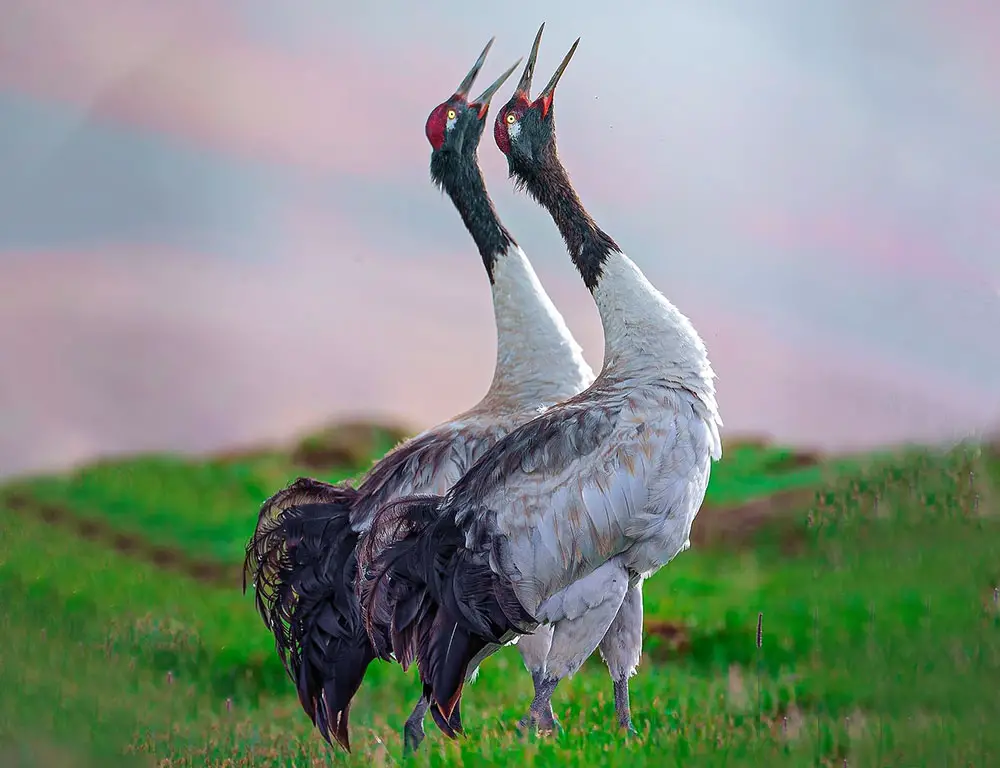
Interesting Physical Characteristics of the Black-Necked Crane
The Black-Necked Crane is a majestic bird renowned for its striking appearance and graceful demeanor. Here are the key physical characteristics that define this iconic species:
Size
The Black-Necked Crane is a large bird with an impressive height of around 140 to 150 centimeters (55 to 59 inches). This stature makes it one of the largest crane species in the world.
Plumage
Its plumage is predominantly white, with black primaries and secondaries, creating a striking contrast against its snowy white body.
The black feathers extend from the wings, forming a distinctive pattern characteristic of the species. The neck is adorned with rich black feathers, giving rise to its name.
Head and Neck
As its name suggests, the Black-Necked Crane is distinguished by its black neck, which contrasts sharply with its white plumage.
The head is small and adorned with a red crown, which adds a splash of color to its otherwise monochromatic appearance. The bill is long and slender, adapted for foraging in wetland habitats.
Legs and Feet
The legs of the Black-Necked Crane are long and slender, enabling it to wade through shallow water with ease. Its feet are large and webbed, providing stability on soft, marshy terrain and facilitating efficient propulsion while swimming.
Wingspan
When fully extended, the wings of the Black-Necked Crane can span an impressive 2 to 2.5 meters (6.6 to 8.2 feet).
This wide wingspan allows for graceful flight, with slow, deliberate wingbeats contributing to the bird’s majestic presence in the sky.
Tail
The tail of the Black-Necked Crane is relatively short, compared to its body size, and is often held erect during flight. While in flight, the tail feathers may fan out slightly, adding to the bird’s aerodynamic profile.
Vocalizations
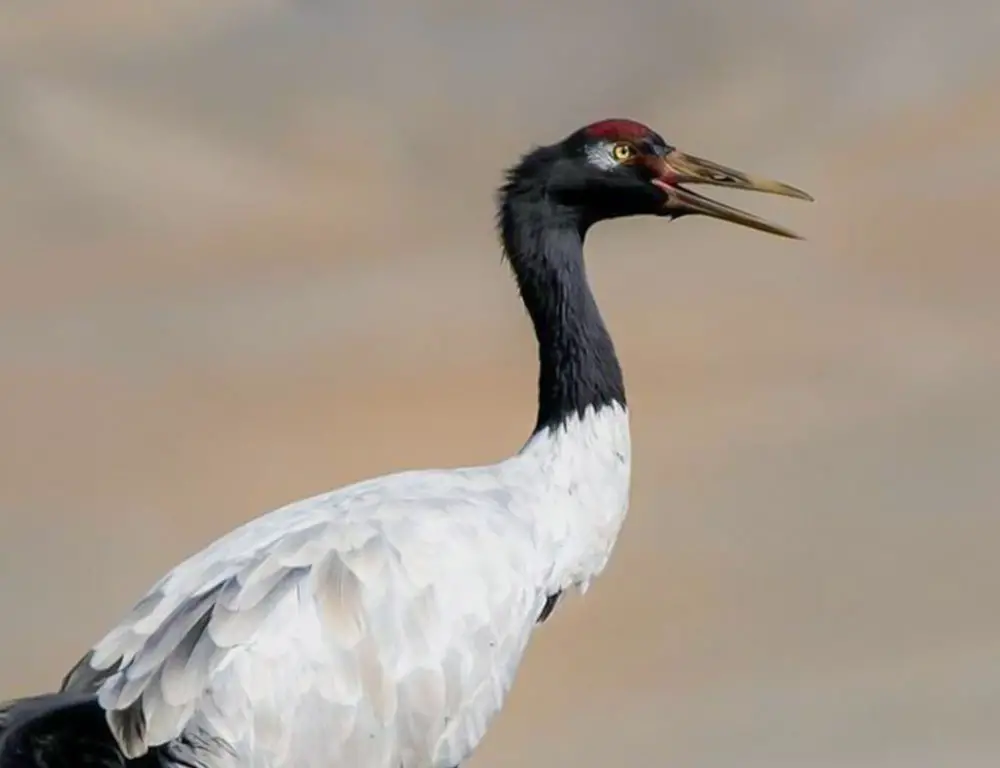
The Black-Necked Crane is known for its distinctive calls, which vary depending on the context. During courtship displays, individuals produce melodious bugling calls that echo across the wetland habitats they inhabit.
These vocalizations are crucial in pair bonding and communication within the species.
Sexual Dimorphism
Regarding physical appearance, male and female Black-Necked Cranes are generally similar, with minor differences in size and plumage coloration.
However, like many crane species, they exhibit subtle variations in behavior and vocalizations during courtship and breeding seasons.
A Deeper Look into the Life History of the Black-Necked Crane
The Black-Necked Crane belongs to the kingdom Animalia, phylum Chordata, class Aves, order Gruiformes, family Gruidae, and genus Grus.
Food Habitat
Black-Necked Cranes are omnivorous birds that primarily feed on a diet of plant matter, including roots, tubers, grains, and grasses.
They also consume small invertebrates such as insects, crustaceans, and small fish when available.
Their foraging habitat consists mainly of wetlands, marshes, meadows, and agricultural fields, where they can find abundant food resources.
Nesting
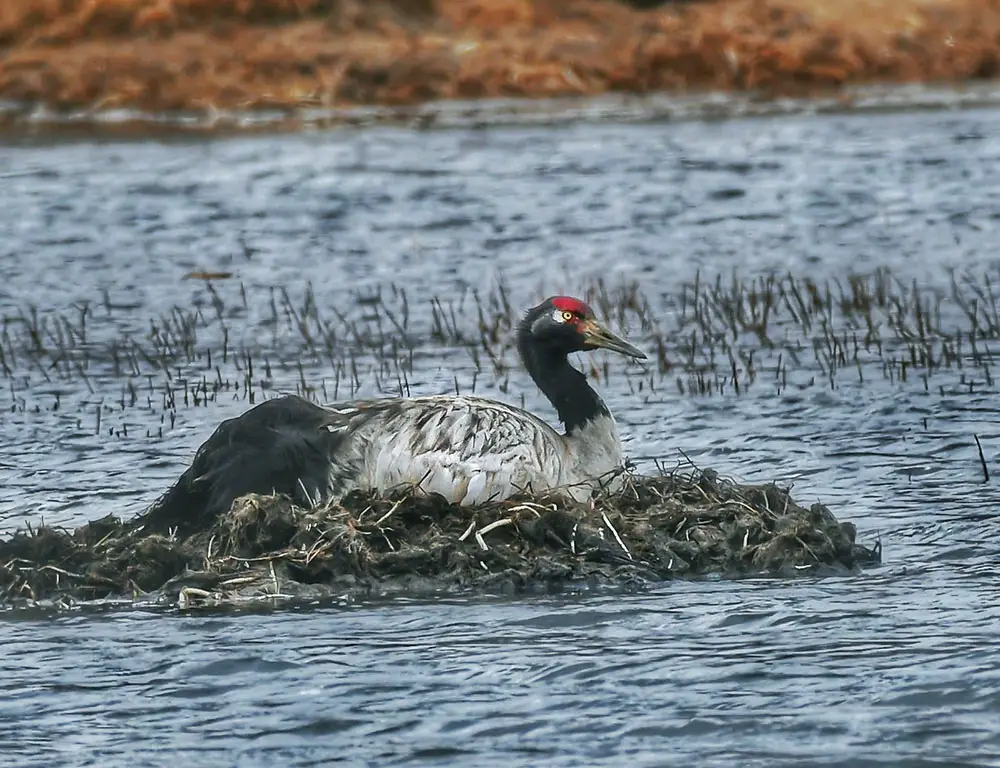
| Nesting Habit | Description |
| Nest Location | Black-Necked Cranes construct their nests in wetland habitats, typically amidst tall grasses or reeds. |
| Nest Structure | Both parents are responsible for incubating the eggs and caring for the chicks after hatching, providing warmth, protection, and food until the young can fledge. |
| Nesting Behavior | Both male and female cranes participate in nest building, with the male often collecting materials while the female arranges them into the nest structure. |
| Egg Laying | Black-Necked Cranes typically lay one to two eggs per clutch, with an incubation period of approximately 30 to 32 days. |
| Parental Care | Both parents share the responsibility of incubating the eggs and caring for the chicks after hatching, providing warmth, protection, and food until the young can fledge. |
Breeding
Breeding season for Black-Necked Cranes usually occurs in the spring, between March and May, coinciding with the thawing of high-altitude wetlands.
During this time, pairs engage in elaborate courtship displays involving synchronized dances, vocalizations, and aerial acrobatics.
Once a pair bond is established, mating occurs, and the female prepares the nest for egg-laying. After the eggs hatch, both parents diligently care for the chicks, teaching them essential survival skills such as foraging and predator avoidance.
Migration
Black-Necked Cranes are known for their seasonal migrations, primarily driven by changes in food availability and weather conditions.
In the summer, they inhabit alpine meadows and wetlands at high elevations, where they breed and raise their young.
As winter approaches, they migrate to lower-altitude areas for warmer temperatures and open water, forming large flocks that gather in wetlands and agricultural fields.
Range Map
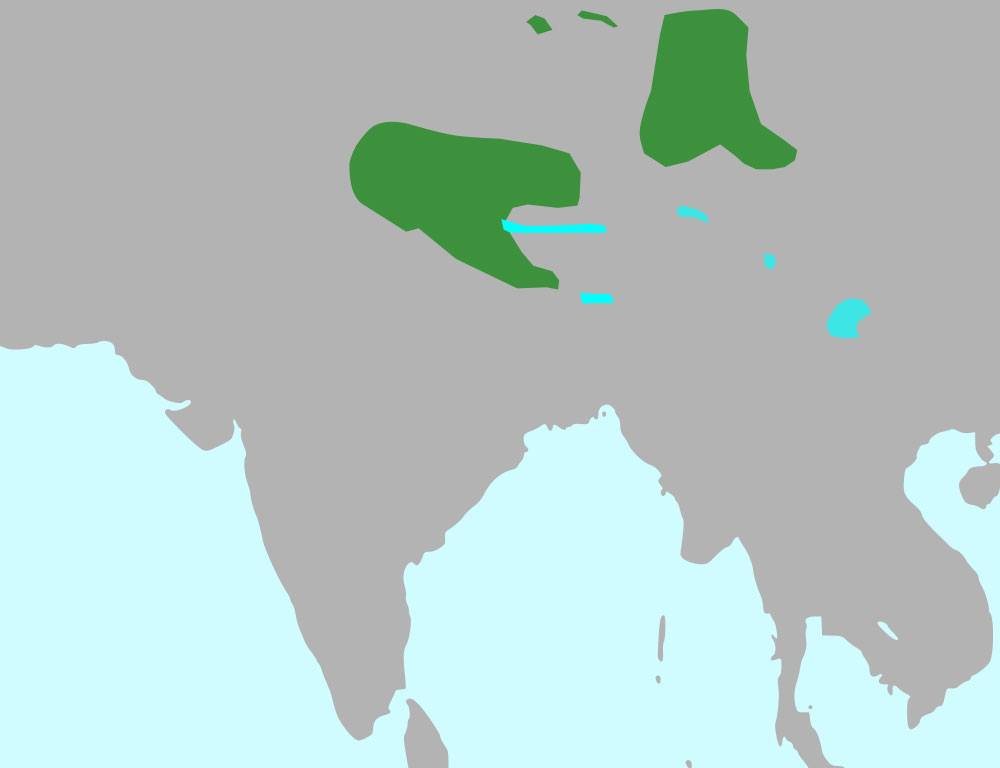
The range of the Black-Necked Crane encompasses the Tibetan Plateau and adjacent areas, including wetlands, marshes, alpine meadows, and agricultural fields.
While the exact distribution may vary seasonally due to migration, breeding populations are concentrated in regions with suitable habitat conditions, such as the Tibetan Autonomous Region of China, Bhutan, and parts of northeastern India.
Conservation Status
The Black-Necked Crane is listed as Vulnerable on the IUCN Red List of Threatened Species. Threats to the species include habitat loss and degradation due to agricultural expansion, infrastructure development, and urbanization.
Human disturbance, including poaching, pollution, and disturbance of breeding and foraging sites, also poses significant threats to the population.
Common Diseases and Treatments of the Black-Necked Crane
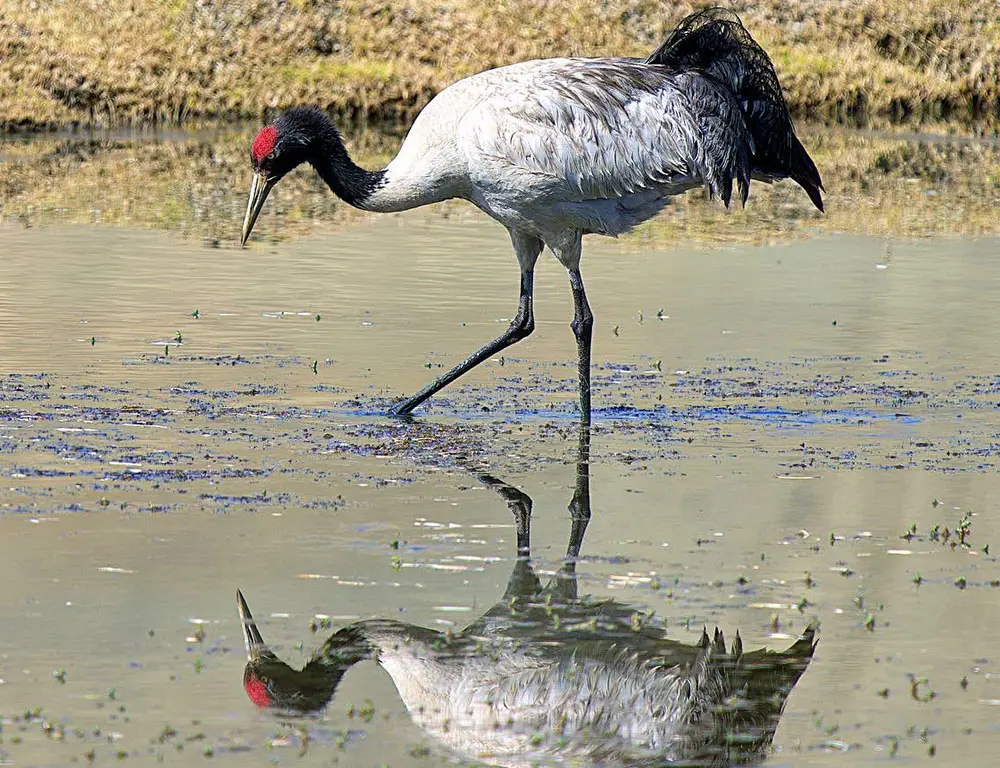
The Black-Necked Crane, like all living organisms, is susceptible to a range of diseases.
While specific diseases may vary depending on habitat, climate, and interactions with other species, several common ailments can affect these majestic birds. Here are some examples of common diseases and potential treatments:
Avian Influenza (Bird Flu)
Avian influenza is a contagious viral infection affecting various bird species, including cranes. Symptoms may include respiratory distress, decreased appetite, lethargy, and sudden death.
Treatment typically involves supportive care, such as providing fluids, maintaining proper nutrition, and isolating affected individuals to prevent the spread of the virus.
Parasitic Infections
Parasites such as internal worms and external parasites like mites and ticks can infest Black-Necked Cranes, leading to weight loss, weakness, and irritation.
Treatment may involve deworming medications and insecticide treatments to eliminate parasites and alleviate symptoms.
Bacterial Infections
Bacterial infections, such as respiratory and bacterial enteritis, can occur in Black-Necked Cranes, particularly in crowded or unsanitary conditions. Symptoms may include coughing, sneezing, diarrhea, and fever.
Treatment typically involves antibiotic therapy to target the specific bacterial pathogens causing the infection.
Lead Poisoning
Lead poisoning can occur in Black-Necked Cranes that ingest lead pellets or contaminated food sources. Symptoms may include weakness, paralysis, and neurological abnormalities.
Treatment involves chelation therapy to remove lead from the bird’s system and supportive care to address secondary complications.
Traumatic Injuries
Traumatic injuries, such as fractures, wounds, and concussions, can occur as a result of collisions with objects or other animals, entanglement in fishing gear, or predation attempts.
Treatment may involve surgical intervention, wound management, and rehabilitation to promote healing and restore mobility.
5 Fun Facts About the Black-Necked Crane
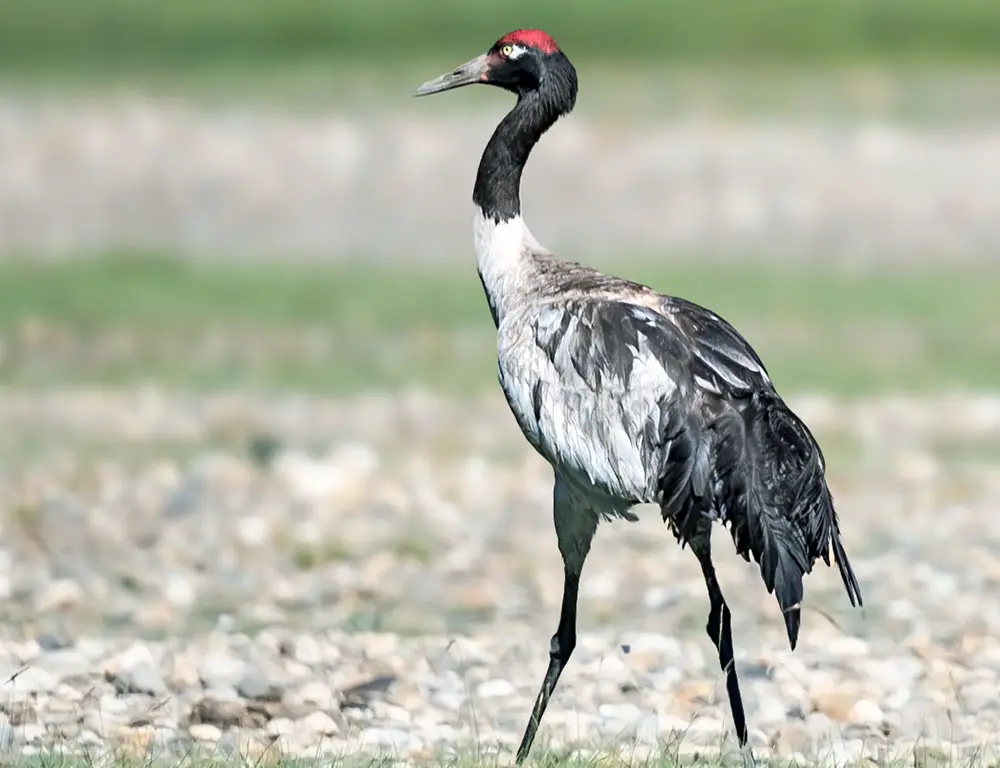
Now, let’s discover five fascinating facts about the majestic Black-Necked Crane:
1. Cultural Symbol
In Bhutan, the Black-Necked Crane is revered as the “bird of happiness” and plays a significant role in local folklore and traditions.
Its arrival in the Kingdom of Bhutan during winter is celebrated with festivals and rituals, symbolizing prosperity and good fortune.
2. Courtship Dance
Black-Necked Cranes engage in elaborate courtship displays, which involve synchronized dances characterized by graceful movements, leaps, and calls.
These mesmerizing displays strengthen pair bonds and serve as a form of communication and expression of affection between mates.
3. Altitude Record
As one of the highest-flying bird species in the world, the Black-Necked Crane is known for its remarkable adaptation to high-altitude habitats.
It has been observed flying at over 7,000 meters (23,000 feet) altitudes during its migratory journeys across the Himalayas.
4. Monogamous Bonds
Black-Necked Cranes form lifelong monogamous pairs, often remaining faithful to their mates for their lives.
This strong bond between partners is reflected in their cooperative behaviors, including nest-building, incubating eggs, and caring for young chicks.
5. Conservation Success
Despite facing threats such as habitat loss and human disturbance, conservation efforts focused on protecting critical wetland habitats and raising awareness about the importance of crane conservation have led to notable successes in safeguarding Black-Necked Crane populations.
FAQs
What is the significance of the Black-Necked Crane in Bhutanese culture?
The Black-Necked Crane holds deep cultural significance in Bhutan, where it is revered as the “bird of happiness” and plays a central role in local folklore and traditions. Its annual arrival in Bhutan during winter is celebrated with festivals and rituals.
What threats do Black-Necked Cranes face in their natural habitat?
Black-Necked Cranes face threats such as habitat loss and degradation due to agricultural expansion, infrastructure development, and urbanization, human disturbance, including poaching, pollution, and disturbance of breeding and foraging sites.
How do Black-Necked Cranes communicate with each other?
Black-Necked Cranes communicate through vocalizations, including bugling calls, honks, and trumpeting sounds. These vocalizations are crucial in courtship displays, pair bonding, and territorial defense.
How do Black-Necked Cranes migrate?
Black-Necked Cranes are migratory birds undertaking long-distance journeys between breeding and wintering grounds. During the summer breeding season, they inhabit high-altitude wetlands and alpine meadows.
What conservation efforts are being implemented to protect Black-Necked Cranes?
Conservation efforts focused on protecting critical wetland habitats, mitigating human-wildlife conflicts, and raising awareness about the importance of crane conservation are essential for ensuring the long-term survival of Black-Necked Cranes.
Conclusion
To wrap it up, the Black-Necked Crane is a testament to the intricate relationship between humans and the natural world.
Its captivating beauty serves as a reminder of the importance of preserving biodiversity and safeguarding fragile ecosystems.
As we strive for harmony between development and conservation, the fate of these majestic birds hangs in the balance.
However, with ongoing efforts to protect their habitats and raise awareness about their plight, there is hope for a brighter future.
By fostering a deeper appreciation for the Black-Necked Crane and the environments it inhabits, we can pave the way for coexistence and sustainability. To explore more, learn about its significance and ecological importance.
Let us join hands in preserving the legacy of this iconic species, ensuring that future generations can marvel at its grace and splendor against the backdrop of our shared planet.
